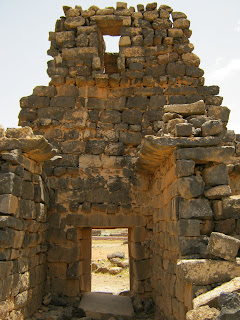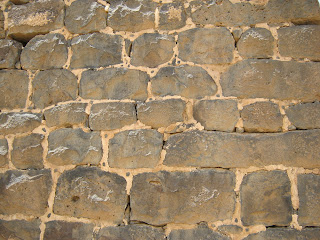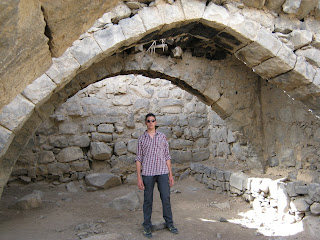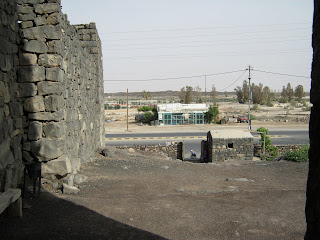
“Far out in the desert, in the midst of a rolling plain, beside the dry bed of an ancient stream, there is a deserted city.... The walls of the ancient deserted city, its half-ruined gates, the towers and arches of its churches, the two and three-story walls of its mansions, all of basalt, rise black and forbidding from the grey of the plain. Many of the buildings have fallen in ruins, but many others preserve their ancient form in such wonderful completeness, that, to the traveler approaching them from across the plain, or viewing them with the aid of a field glass from the nearest crests of the Djebel Haur'n, the deserted ruin appears like a living city, all of black, rising from a grey-white sea” (H. C. Butler, Princeton Expedition to Syria II, 1913: 149-50). The words of Butler as he approached Umm al-Jimal are far superior to any words I might craft in an attempt to convey the majesty of these beautiful ruins in northern Jordan. Driving down the lane leading to the town, seeing the ruins beginning to come into view made my heartbeat just a bit faster and my breaths just a bit shallower. I was so excited to see this marvel of basalt I could barely
contain my excitement!
Umm al-Jimal (Mother of the Camel) is remarkable because of the substantial ruins of a Byzantine and early Islamic town that are clearly visible above ground. The town was first settled in the 2nd century CE after the famed Emperor Trajan annexed the Nabatean Empire into the Roman Empire and called it Arabia Petraea. Queen Zenobia (Julia Aurelia Zenobia Cleopatra), the ruler of Syria decided to revolt against the Romans in the mid-3rd century, and was somewhat successful in that she conquered Egypt and ruled it until 274 CE. It was during this revolt that most scholars agree the city of Umm al-Jimal was destroyed.She managed to rule for a few years until Rome came back and conquered her and her kingdoms again. She was taken to Rome and paraded through the streets in golden chains to show the Roman citizenry the power and majesty of the Empire.
The stones used to build the town were cut from the quarries of basalt in the plains nearby and the houses, store-rooms, churches were constructed in the unique Haur’n architectural style. Because of its location on the arid, treeless plains there was absolutely no wood for building. The stone was shaped in such ways as to replace wood and nails.
Walking through the streets and buildings and churches filled me with awe and wonder. Nineteen centuries have passed and the town is still astonishingly preserved despite wars and earthquakes. One can't help feeling a sense of insignificance when surrounded by such rich history.
The architecture is something to behold. Notice in the photographs that no concrete or mud was used in the construction, but the stones are cunningly shaped to fit perfectly, like a jigsaw puzzle.
 |
| Dry fitted stones still standing after nearly 2000 years |
 |
| Floor joists, for lack of a better word; these stones supported the floors laid above |
 |
| Stairs leading to the upper floors |
 |
| Greek inscriptions in the stones |
 |
| Notice the supports in these four pictures. The floor supports were lain on them and the floors built over that |
 |
| A magnificent arch |
 |
| Looking upward at the underside of a second story floor |
I think I could have wandered about this town for day without tiring of it. The wonders of it! The history! It seemed I could hear, just barely, the voices from the past with stories to tell. Stories of building homes, raising families and enjoying life in this beautiful, dark town. The black basalt stones at first seemed to be drab and depressing. But seeing the ingenuity of the construction, the open lay-out made me think the ancients lived happily here until Zenobia got up to her shenanigans.
Enjoy a few more pictures before we travel to the desert castles.
 |
| Zeek and Ramzi chatting with the caretaker |
 |
| Our friend, and Zeek's classmate, Ramzi |
 |
| Notice the door at ground level in the background. It was the only example of white stone we saw |
 |
| Ol' Big Jim hobbling round, trying to see every single thing! |
 |
| First time in my life I ever saw a door too short for me to walk through! |
 |
| Ramzi |
 |
| Oops, looks like Ol' Big Jim has spotted a treasure on the ground |
 |
| "Little" Ramzi...so tall he can't completely fit into a photo! |
 |
| Capital from an old column |
 |
| Notice the wall is leaning inward, probably as a result of a catapult that destroyed the central section |
 |
| Visitor's Center |
 |
| Remains of a church. There were many churches in this town in the Byzantine era |
 |
| Amazing! An ancient Ace of Spades! Made of plastic too, and from China! Who knew they were already so active 1900 years ago?? |
 |
| I'd really like to know the story behind this stone, but sadly I haven't gotten it yet |
 |
| Leaving Umm al-Jimal behind...for now |
 |
| Tourist Police headquarters |
As we left Umm al-Jimal behind I was stricken by the utter flatness of the landscape in stark comparison to the mountainous regions just a few kilometers south. I had to make a couple of pictures of the seemingly endless fields we drove through to get to our next destination.
 |
| The earth here is quite fertile and grows very nice wheat |
Our next stop was al-Hallabat, another ancient castle in the desert. Due to restoration activities we decided to save it for a later visit. I'll tell you all about it another time. We did make a few pictures at the visitors center, though. They have a very nice exhibit at the entrance showcasing some of the architectural elements that have been recovered. There is also a wall with inscribed basalt stones that is very nicely done. I was very impressed by the fact that they are generating their power through solar cells. The Tourist Police invited us into the office and served us coffee as we chatted about where we came from, what we're doing and so on. They seemed genuinely happy to see us, and treated us with that famous Arab hospitality I'm always going on about. I'm looking forward to our return visit.
 |
| I saw this house as we were leaving al-Hallabat and couldn't resist a photo. I love the gate! |
Our last stop of the day was at Qasr Azraq. It too dates back to the Roman Empire and was later taken by the Muslims. It is said that Lawrence of Arabia spent some time here during the Great Arab Revolt against Great Britain.
 |
| I saw the flowers growing at the front gate and instantly thought of my Aunt Frances. I knew I had to have pictures of them for her. |
 |
| Notice the mosque built in the center of the castle keep. Stones were cannibalized from broken buildings in order to build it |
 |
| Zeek lifting a stone. As it was sitting in a bowl-like structure, it might have been a grinding stone. However, I am more inclined to believe, due to its weight that it may actually have been a catapult stone |
 |
| Gawd, I love a porch! |
 |
| Looking out to see if you are looking back to see if I am looking back to see if you are looking back at me... |
 |
| Interior of the impressively built mosque |
 |
| You think climbing that stair was easy for an old fat man? |
 |
| A bit easier for "Little" Ramzi |
 |
| Ol' Big Jim standing in the Qibla of the mosque |
 |
| I'm not sure about this place. May have been a market place. Notice the beautiful arches; again with no cement! |
 |
| Exterior of mosque |
 |
| The little "museum" had a few artefacts on display. Sadly the were poorly identified |
 |
| I noticed quite a lot of stones carven with animal motif, much like the mosaics in the southern cities, Madaba in particular |
 |
| Ahlan, ahlan al Urdun! |
 |
| Welcome to Jordan! |
Come back to visit me soon. I'll have more stories to tell and sights to share!






















































































































































No comments:
Post a Comment